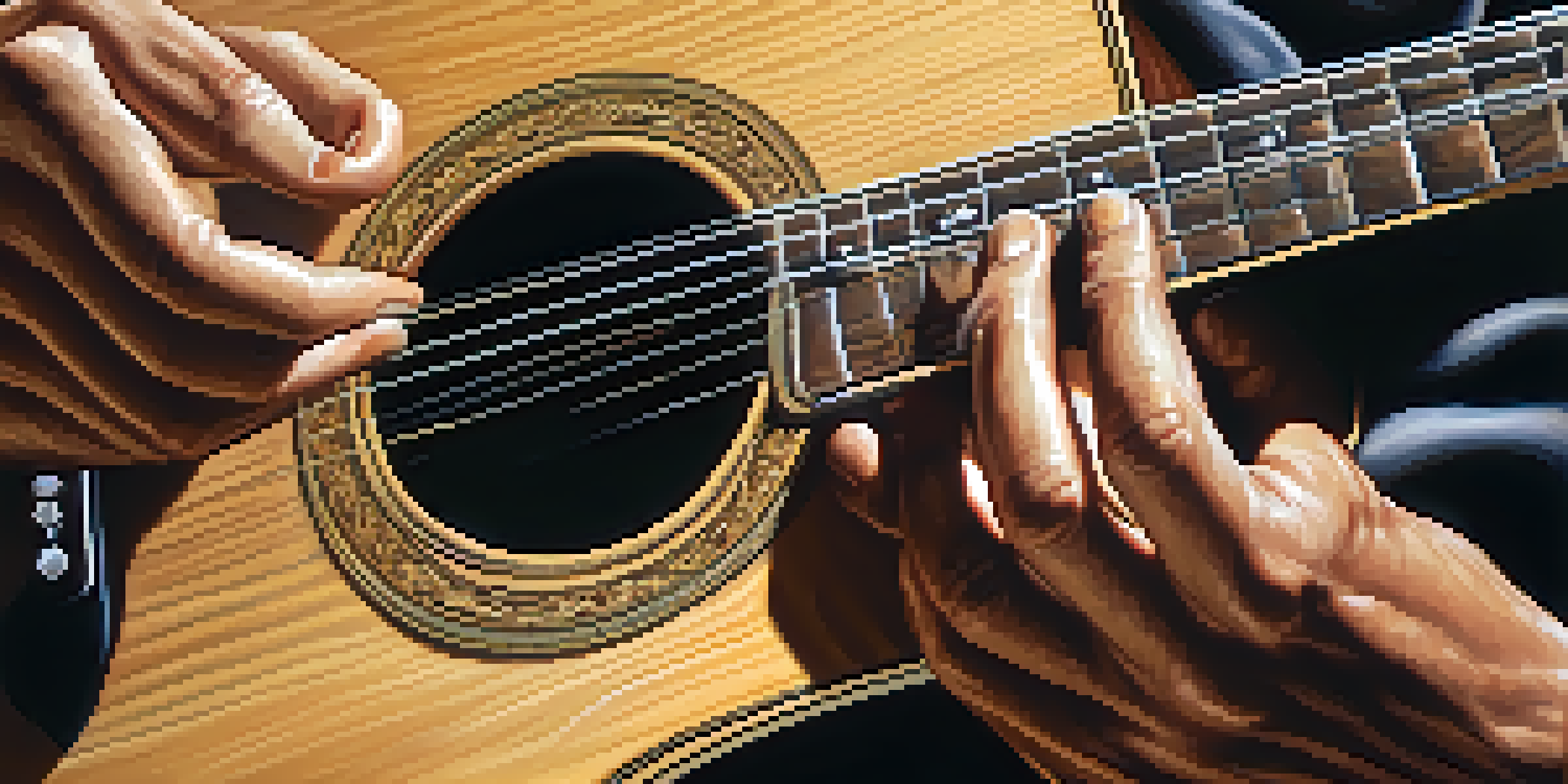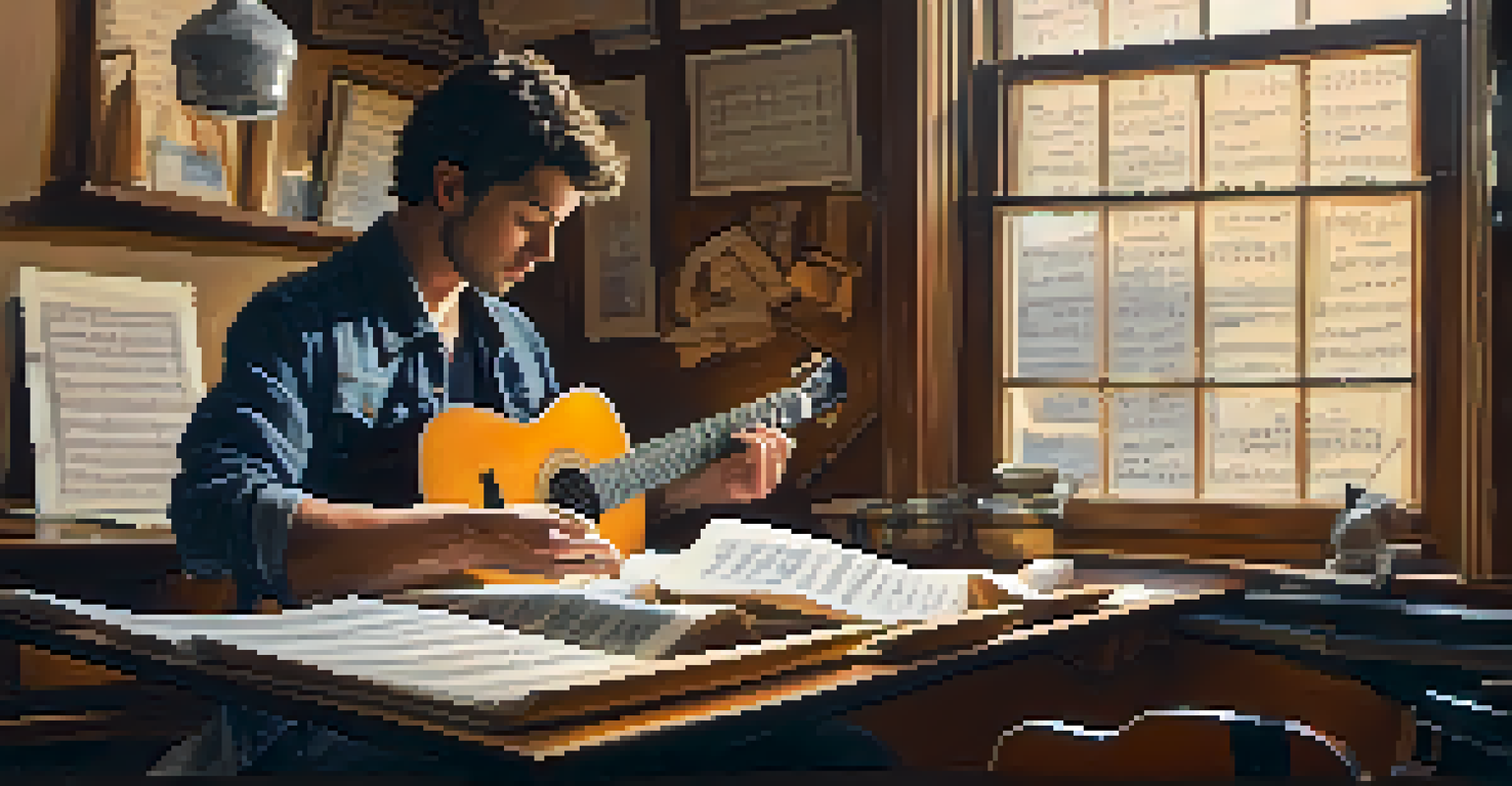Incorporating Fingerpicking Styles in Your Guitar Compositions

Understanding the Basics of Fingerpicking Techniques
Fingerpicking is a technique that allows guitarists to play multiple notes simultaneously using their fingers instead of a pick. It creates a rich, textured sound that can enhance your compositions significantly. By using your thumb and fingers independently, you can achieve intricate melodies and harmonies that stand out.
Music is the shorthand of emotion.
To get started, familiarize yourself with basic fingerpicking patterns, such as the Travis picking style. This pattern alternates between bass notes played with your thumb and melody notes plucked with your fingers. As you practice, focus on keeping a steady rhythm, which is crucial for developing your fingerpicking skills.
Once you feel comfortable with the basics, experiment with different fingerpicking styles. There are countless variations, each offering unique sounds and textures. By incorporating these techniques into your compositions, you can create a more dynamic and engaging musical experience.
Choosing the Right Fingerpicking Patterns for Your Music
Selecting the right fingerpicking pattern can set the mood for your composition. For example, a gentle, flowing pattern might suit a romantic ballad, while a more syncopated style could work well for upbeat folk tunes. Consider the emotional tone you want to convey and choose a pattern that complements it.

You can also create your own unique patterns by combining elements from different styles. Start with a simple base and gradually add variations to keep things interesting. This will not only make your compositions more captivating but also help showcase your personal style as a guitarist.
Master Fingerpicking Techniques
Practicing various fingerpicking styles and patterns is essential for developing your skills and enhancing your compositions.
As you experiment with different patterns, pay attention to how they interact with your chord progressions. Sometimes, a subtle change in your picking pattern can elevate a simple chord sequence into something extraordinary. Don’t be afraid to play around until you find the perfect fit.
Incorporating Fingerpicking into Your Songwriting Process
Fingerpicking can be a powerful tool in your songwriting toolkit. Start by jotting down a chord progression that resonates with you, then try adding fingerpicking patterns to create depth. This approach can inspire melodic ideas and lyrical content, enhancing your overall songwriting experience.
Guitar is the best instrument. It’s like playing a piece of art.
One effective technique is to record yourself playing a simple chord progression, then layer different fingerpicking patterns over it. This can help you discover unexpected harmonies and melodies that might not come to you while just strumming. It’s a fun way to break out of creative ruts and spur new ideas.
Remember, songwriting is a personal journey. Don’t hesitate to borrow elements from your favorite songs or artists, but always strive to add your unique touch. Fingerpicking offers endless possibilities, so let your creativity flow and see where it takes you.
Exploring Different Genres with Fingerpicking Styles
Fingerpicking isn't just for folk music; it's a versatile technique that can enhance various genres. From blues to classical, each genre has its own distinct fingerpicking styles. Exploring these styles can open new avenues for your compositions and help you develop a more diverse musical palette.
For instance, if you're interested in blues, try incorporating slide techniques with your fingerpicking. This combination can create a raw, expressive sound that resonates deeply with listeners. On the other hand, classical fingerstyle techniques can introduce intricate melodies and harmonies, elevating your compositions to new heights.
Explore Genre Diversity
Incorporating fingerpicking into different musical genres can inspire new ideas and create unique, engaging compositions.
By experimenting with different genres and their associated fingerpicking styles, you can find fresh inspiration for your music. This exploration encourages growth as a musician and can lead to unique, genre-blending compositions that stand out.
Practicing Fingerpicking Techniques Effectively
Like any musical skill, mastering fingerpicking requires dedicated practice. Start with slow exercises to build muscle memory, then gradually increase the tempo as you become more comfortable. Consistency is key, so set aside time each day to focus on your fingerpicking techniques.
Incorporating a metronome into your practice can help you develop a steady rhythm. Start at a slower pace and gradually increase the speed as you gain confidence. This method not only improves your timing but also helps you to maintain control over your finger movements.
Don’t be discouraged by initial difficulties; fingerpicking can be challenging at first. Celebrate small victories, and remember that improvement comes with time and patience. By staying committed to your practice, you'll soon find your fingerpicking skills becoming second nature.
Analyzing Fingerpicking from Influential Guitarists
Learning from the masters can provide invaluable insights into fingerpicking techniques. Artists like Tommy Emmanuel and Chet Atkins have pioneered unique fingerstyle approaches that are worth studying. By analyzing their performances, you can pick up tips and tricks to incorporate into your own playing.
Watch live performances and instructional videos to observe their hand movements and techniques. Take notes on how they structure their fingerpicking patterns and how they integrate them into their songs. This analysis can inspire your own creativity and help you refine your style.
Share Your Original Compositions
Recording and sharing your fingerpicked music online can help you connect with a broader audience and foster a supportive community.
Don’t forget to try playing along with your favorite fingerstyle pieces. This hands-on approach can deepen your understanding of the techniques used and allow you to internalize them. Over time, you’ll develop your unique voice while paying homage to those who came before you.
Recording and Sharing Your Fingerpicked Compositions
Once you've developed your fingerpicking skills and composed some original pieces, it's time to share your music. Recording your compositions can be a rewarding experience, allowing you to capture your creativity and progress. Consider using basic recording software to get started; many options are user-friendly and accessible to beginners.
When recording, pay attention to the tone and dynamics of your fingerpicking. Experiment with microphone placement or use audio effects to enhance the overall sound. This attention to detail will help your music shine and resonate with your audience.

Finally, don’t underestimate the power of sharing your work online. Platforms like social media, music streaming services, and video-sharing sites can help you reach a wider audience. Engaging with fellow musicians and listeners can foster a supportive community and inspire you to keep evolving as an artist.